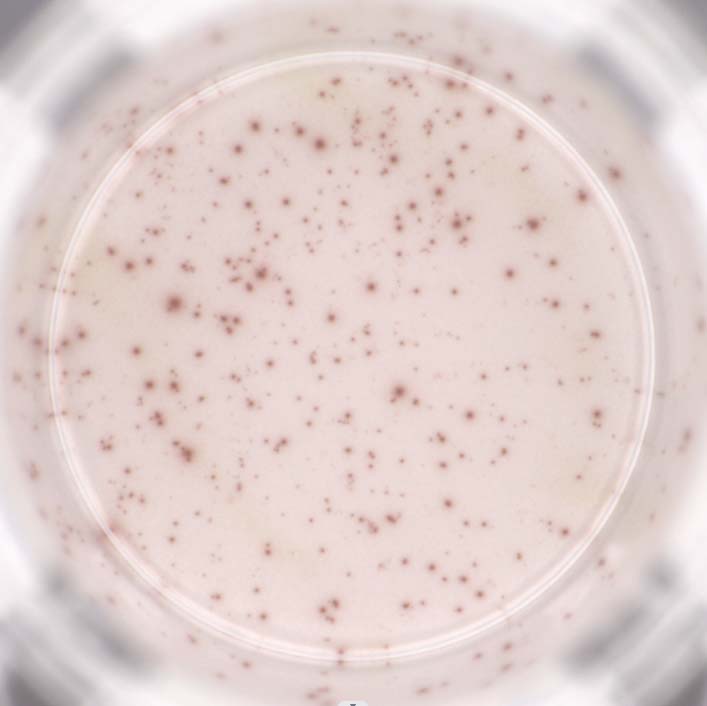组分(Materials Provided)
| ID | Components | Size |
| RSP004-C01 | Pre-coated Anti-TNF-α Antibody Microplate | 1 plate |
| RSP004-C02 | Positive Stimulus | 20 μg |
| RSP004-C03 | Biotin-Anti-TNF-α Antibody | 50 μL |
| RSP004-C04 | Streptavidin-HRP | 50 μL |
| RSP004-C05 | Washing Buffer (10x) | 50 mL |
| RSP004-C06 | Dilution Buffer (1x) | 50 mL |
| RSP004-C07 | AEC Dilution | 25 mL |
| RSP004-C08 | AEC Solution A (20x) | 0.8 mL |
| RSP004-C09 | AEC Solution B (20x) | 0.8 mL |
| RSP004-C10 | AEC Solution C (20x) | 0.8 mL |
产品概述(Product Overview)
Tumor necrosis factor-alpha (TNF-α) is a multifunctional Th1 cytokine and one of the most important inflammatory cytokines. It is produced by macrophages during inflammation and can also be activated by the endotoxin lipopolysaccharide (LPS). The Mouse TNF-α ELISpot assay is designed for the detection of mouse TNF-α secreting cells at the single cell level and can be used to quantitate the frequency of mouse TNF-α secreting cells. ELISpot assays are highly reproducible and sensitive, and can be used to measure responses with frequencies well below 1 in 100,000. ELISpot assays do not require prior in vitro expansion of T cells and they are suitable for high-throughput analysis using only small volumes of primary cells. As such, ELISpot assays are useful tools for research in vaccine development, cytokine secretion and the monitoring of various clinical trials.
应用说明(Application)
This kit is used to detect TNF-alpha at the cellular level.
It is for research use only.
重构方法(Reconstitution)
Please see Certificate of Analysis for details of reconstitution instruction and specific concentration.
存储(Storage)

原理(Assay Principles)
ELISpot assays employ the quantitative sandwich enzyme-linked immunosorbent assay (ELISA) technique. The Kit consists of Pre-coated Anti-TNF-α Antibody Microplate, Positive Stimulus, Biotin-Anti-TNF-α Antibody, Streptavidin-HRP, AEC and buffers.
Your experiment will include 6 simple steps:
a) A monoclonal antibody specific for mouse TNF-α has been pre-coated onto a polyvinylidene difluoride (PVDF)-backed microplate.
b) Appropriately stimulated cells are pipetted into the wells and the microplate is placed into a humidified 37 °C CO2 incubator for a specified period of time.During this incubation period, the immobilized antibody in the immediate vicinity of the secreting cells binds secreted TNF-α.
c) After washing away any cells and unbound substances, a biotinylated antibody specific for mouse TNF-α is added to the wells. Following a wash to remove any unbound biotinylated antibody, HRP conjugated to streptavidin is added.
d) Wash the plate and add the Streptavidin-HRP diluted by Dilution Buffer to the plate.
e) Wash the plate and add AEC. A reddish-brown colored precipitate forms and appears as spots at the sites of cytokine localization, with each individual spot representing an individual TNF-α secreting cell.
f) The spots can be counted with an automated ELISpot reader system or manually using a stereomicroscope.
质量管理控制体系(QMS)
典型数据-Typical Data Please refer to DS document for the assay protocol.

5x10⁴ cells/well Mouse Spleen Cells were stimulated with 0.1 μg/mL Positive Stimulus and cultured at 37℃ and 5%CO2 for 20 h, 208 spots were produced. The following example data is for reference only.























































 膜杰作
膜杰作 Star Staining
Star Staining















